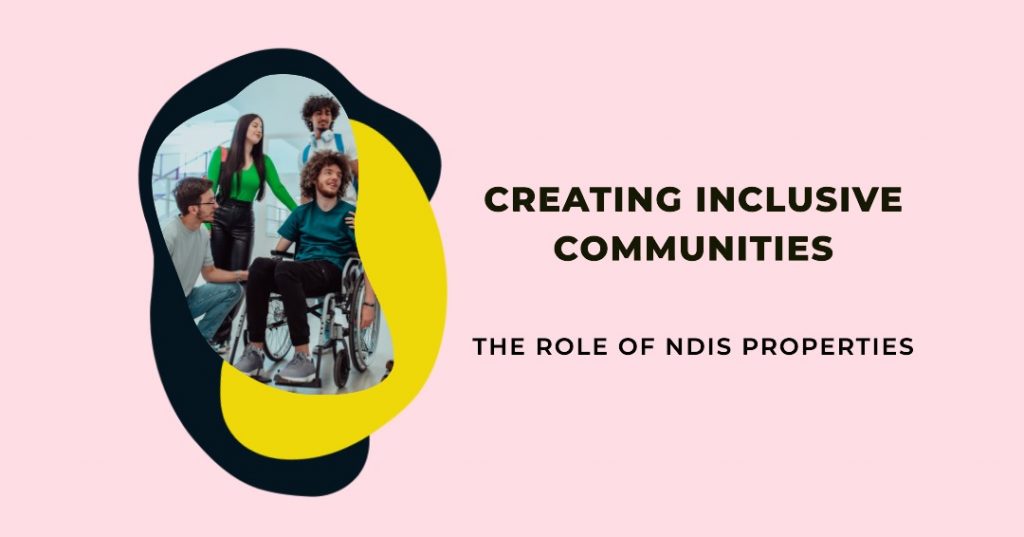
Inclusive communities are essential for the well-being and success of individuals with disabilities. Creating environments that foster a sense of belonging and provide equal opportunities for all members of society is not only a moral imperative but also a critical component of building thriving, diverse neighborhoods. One crucial aspect of this inclusivity is the development and integration of National Disability Insurance Scheme (NDIS) properties, which serve as accessible housing options for those with disabilities. By understanding the importance of accessible housing, designing properties that cater to the unique needs of individuals with disabilities, and promoting social engagement and interaction, we can work towards building truly inclusive communities.
NDIS properties play a significant role in fostering inclusivity by providing housing that is specifically designed to accommodate the needs of individuals with disabilities. By adhering to design principles that prioritize accessibility and functionality, these properties can empower residents to live independently and comfortably. Furthermore, integrating NDIS properties into the wider community encourages social interaction and engagement, helping to break down barriers and promote understanding between individuals with and without disabilities. In order to truly assess the impact of NDIS properties on inclusivity, it is essential to evaluate their effectiveness in fostering a sense of belonging and connection among residents and the broader community.
Understanding the Importance of Accessible Housing
Imagine the sense of freedom and independence you’d feel living in a home designed with accessible features, making everyday tasks and activities easier for you to navigate. Accessible housing plays a crucial role in creating inclusive communities, as it allows individuals with disabilities to fully participate in society and lead independent lives. This type of housing is designed with the specific needs of people with disabilities in mind, ensuring that they can move around their homes safely and comfortably. It includes features such as wider doorways, ramps, and accessible bathrooms, which cater to the unique needs of individuals with disabilities.
The importance of accessible housing cannot be overstated, as it not only provides a safe and comfortable living environment for people with disabilities, but also promotes social inclusion and fosters a sense of belonging within the community. By having access to housing that meets their needs, individuals with disabilities can build connections with their neighbors, engage in community activities, and lead fulfilling lives. Moreover, accessible housing plays a significant role in reducing the reliance on support services, as individuals with disabilities can carry out everyday tasks independently. Thus, investing in accessible housing is essential for creating inclusive communities that value and respect the rights and needs of all individuals.
Design Principles for NDIS Properties
You’ll find that well-thought-out design principles for these spaces can truly touch hearts and inspire a sense of belonging for everyone involved. Central to creating inclusive communities through NDIS properties is the concept of universal design, which focuses on creating environments that cater to the needs of all individuals, regardless of their age, size, ability, or disability. This approach ensures that spaces are both functional and aesthetically pleasing, promoting a high quality of life for everyone who lives or spends time in the community. Key principles of universal design include equitable use, flexibility in use, simple and intuitive design, perceptible information, tolerance for error, low physical effort, and appropriate size and space for approach and use.
In addition to universal design, incorporating assistive technology into NDIS properties can further enhance the inclusiveness of these spaces. Assistive technology includes any device, system or design that allows individuals with disabilities to perform tasks that they would otherwise be unable to do, or increase the ease and safety with which tasks can be performed. Examples of assistive technology include ramps, lifts, automated doors, adjustable countertops, and smart home systems that can be controlled via voice commands or mobile devices. By integrating these technologies into the design of NDIS properties, we can create environments that empower individuals with disabilities, enabling them to live independently and participate fully in their communities.
Fostering Social Engagement and Interaction
It’s essential to foster social engagement and interaction in living spaces, making everyone feel connected and valued, regardless of their abilities. NDIS properties play a vital role in creating inclusive communities by providing accessible and comfortable living environments for people with disabilities. To achieve this, these spaces must be designed with the intent to encourage social interactions, promote participation in community activities, and enable individuals to build strong connections with their neighbors and the wider community.
To foster social engagement and interaction in NDIS properties, various design elements and strategies should be considered. These may include incorporating shared common areas, such as gardens, lounges, and recreational spaces, which encourage residents to spend time together and engage in various activities. Additionally, the layout of the properties should promote ease of movement and access to communal spaces, ensuring that all residents can conveniently participate in social events and activities. By creating living environments that support and encourage social interactions, NDIS properties can play a significant role in promoting inclusivity and empowering individuals with disabilities to lead fulfilling lives within their communities.
Integrating NDIS Properties into the Wider Community
As you settle into your new living space, you may find that integrating NDIS properties into the wider community can significantly enhance your sense of belonging and connection. By actively participating in local events, collaborating with community organizations, and fostering open communication with neighbors and community members, NDIS participants can contribute to the creation of an inclusive and diverse community environment. This not only benefits the NDIS participants themselves but also enriches the experiences of those living in the surrounding community by promoting understanding and acceptance of people with disabilities.
One effective way to integrate NDIS properties into the wider community is through the establishment of partnerships with local businesses, schools, and community organizations. These partnerships can provide opportunities for NDIS participants to engage in various activities, such as volunteering, attending workshops, and participating in social events. Additionally, they can serve as a platform for NDIS participants to showcase their talents and abilities, thus breaking down barriers and challenging misconceptions about disabilities. By actively engaging in these opportunities and working together to create a more inclusive community, NDIS participants can build strong connections and contribute positively to the wider community.
Evaluating the Impact of NDIS Properties on Inclusivity
To truly gauge the impact of NDIS properties on fostering inclusivity, it’s crucial to examine the tangible outcomes and benefits that arise from integrating these properties into the broader community. One way to evaluate this impact is by measuring the increased access to and participation in various community activities by individuals with disabilities. This could include access to public spaces, recreational facilities, and local events that are tailored to accommodate diverse needs. Additionally, measuring the level of interaction between individuals with disabilities and their non-disabled peers within these shared spaces can provide insight into the effectiveness of NDIS properties in promoting social inclusion.
Another method to assess the impact of NDIS properties on inclusivity is by analyzing the experiences and perspectives of individuals with disabilities who reside in these properties. This could involve conducting surveys or interviews to gather feedback on their overall satisfaction with the living arrangements and the extent to which they feel integrated into the community. Furthermore, it’s important to consider the perspectives of community members who interact with individuals with disabilities, as this can provide valuable insight into any barriers that may still exist and the overall success of the NDIS property initiative in fostering a more inclusive community.
Frequently Asked Questions
How can property developers and local authorities collaborate to ensure a sufficient supply of NDIS properties in their communities?
Property developers and local authorities can collaborate by identifying suitable locations, sharing resources, and streamlining approval processes to ensure adequate supply of accessible housing options in their communities.
What specific challenges do individuals with disabilities face in the current housing market, and how do NDIS properties address these issues?
Individuals with disabilities face limited accessibility, affordability, and suitable housing options. NDIS properties address these issues by providing accessible, affordable, and tailored housing solutions to meet their specific needs.
What are some innovative ways to fund and finance the development of NDIS properties to ensure their affordability and availability to those in need?
Innovative funding methods for accessible housing can include government grants, public-private partnerships, community land trusts, and social impact bonds, which could increase affordability and availability for those with disabilities.
How can NDIS properties cater to the diverse needs of individuals with disabilities, including those with physical, sensory, cognitive, and mental health disabilities?
To cater to diverse needs of individuals with disabilities, properties should incorporate universal design principles, adaptable spaces, sensory-friendly environments, and supportive technology to accommodate physical, sensory, cognitive, and mental health disabilities.
What role can technology and smart home features play in enhancing the accessibility and inclusivity of NDIS properties for people with disabilities?
Technology and smart home features can significantly improve accessibility and inclusivity for people with disabilities, allowing customized solutions, automation, and remote control of various home functions, fostering independence and safety.
Conclusion
In conclusion, NDIS properties play a crucial role in creating inclusive communities. They not only provide accessible housing but also encourage social interactions among residents.
By integrating these properties into the wider community, we’re able to promote inclusivity and improve the quality of life for individuals with disabilities. It’s important to continue evaluating the impact of NDIS properties to ensure their ongoing success in fostering inclusivity.






